现代投资组合理论与投资分析
- 格式:doc
- 大小:110.00 KB
- 文档页数:4
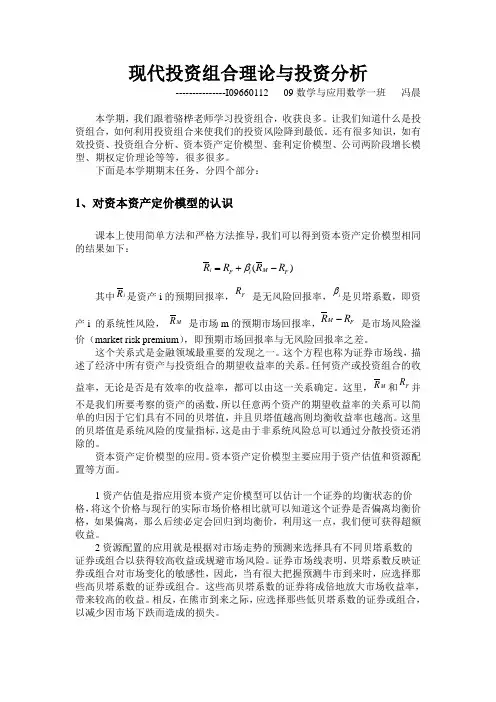
现代投资组合理论与投资分析---------------I09660112 09数学与应用数学一班 冯晨本学期,我们跟着骆桦老师学习投资组合,收获良多。
让我们知道什么是投资组合,如何利用投资组合来使我们的投资风险降到最低。
还有很多知识,如有效投资、投资组合分析、资本资产定价模型、套利定价模型、公司两阶段增长模型、期权定价理论等等,很多很多。
下面是本学期期末任务,分四个部分:1、对资本资产定价模型的认识课本上使用简单方法和严格方法推导,我们可以得到资本资产定价模型相同的结果如下:()i M F i F R R R R β=+-其中i R 是资产i 的预期回报率,FR 是无风险回报率,i β是贝塔系数,即资产i 的系统性风险, M R 是市场m 的预期市场回报率,M F R R - 是市场风险溢价(market risk premium ),即预期市场回报率与无风险回报率之差。
这个关系式是金融领域最重要的发现之一。
这个方程也称为证券市场线,描述了经济中所有资产与投资组合的期望收益率的关系。
任何资产或投资组合的收益率,无论是否是有效率的收益率,都可以由这一关系确定。
这里,M R 和FR 并不是我们所要考察的资产的函数,所以任意两个资产的期望收益率的关系可以简单的归因于它们具有不同的贝塔值,并且贝塔值越高则均衡收益率也越高。
这里的贝塔值是系统风险的度量指标,这是由于非系统风险总可以通过分散投资还消除的。
资本资产定价模型的应用。
资本资产定价模型主要应用于资产估值和资源配置等方面。
1资产估值是指应用资本资产定价模型可以估计一个证券的均衡状态的价格,将这个价格与现行的实际市场价格相比就可以知道这个证券是否偏离均衡价格,如果偏离,那么后续必定会回归到均衡价,利用这一点,我们便可获得超额收益。
2资源配置的应用就是根据对市场走势的预测来选择具有不同贝塔系数的证券或组合以获得较高收益或规避市场风险。
证券市场线表明,贝塔系数反映证券或组合对市场变化的敏感性,因此,当有很大把握预测牛市到来时,应选择那些高贝塔系数的证券或组合。
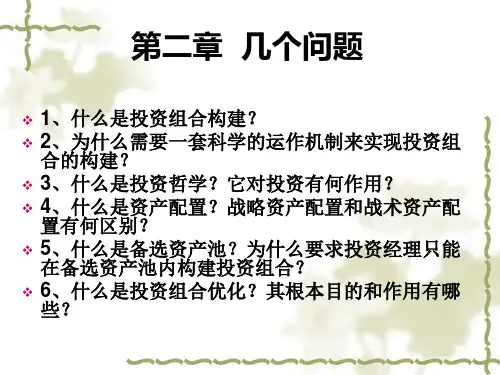
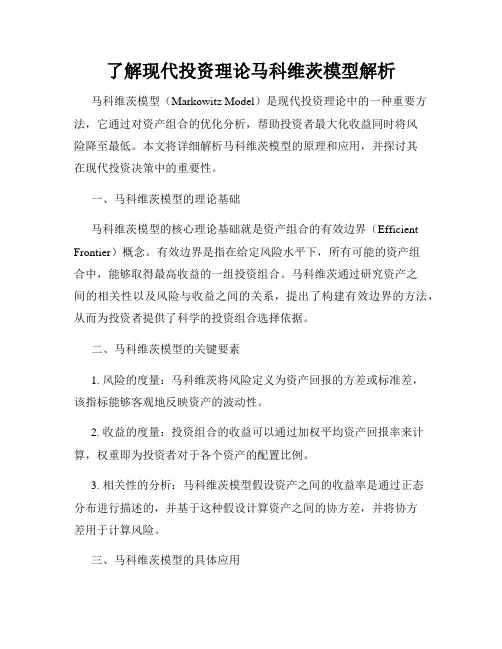
了解现代投资理论马科维茨模型解析马科维茨模型(Markowitz Model)是现代投资理论中的一种重要方法,它通过对资产组合的优化分析,帮助投资者最大化收益同时将风险降至最低。
本文将详细解析马科维茨模型的原理和应用,并探讨其在现代投资决策中的重要性。
一、马科维茨模型的理论基础马科维茨模型的核心理论基础就是资产组合的有效边界(Efficient Frontier)概念。
有效边界是指在给定风险水平下,所有可能的资产组合中,能够取得最高收益的一组投资组合。
马科维茨通过研究资产之间的相关性以及风险与收益之间的关系,提出了构建有效边界的方法,从而为投资者提供了科学的投资组合选择依据。
二、马科维茨模型的关键要素1. 风险的度量:马科维茨将风险定义为资产回报的方差或标准差,该指标能够客观地反映资产的波动性。
2. 收益的度量:投资组合的收益可以通过加权平均资产回报率来计算,权重即为投资者对于各个资产的配置比例。
3. 相关性的分析:马科维茨模型假设资产之间的收益率是通过正态分布进行描述的,并基于这种假设计算资产之间的协方差,并将协方差用于计算风险。
三、马科维茨模型的具体应用1. 优化投资组合:马科维茨模型可以帮助投资者在给定风险水平下,找到最合理的资产配置方案,从而达到收益最大化的目标。
2. 风险控制与分散:通过马科维茨模型,投资者可以分散投资组合中的风险,通过权衡不同资产之间的相关性,将风险降至最低。
3. 战略分析与决策:马科维茨模型还可以帮助投资者进行战略分析和决策,通过对不同资产的回报率和方差进行评估,确定最佳投资策略。
四、马科维茨模型的局限性1. 假设限制:马科维茨模型建立在一系列假设的基础上,如资产收益率符合正态分布假设、相关性的稳定性等,这些假设在实际市场中并不总是成立。
2. 数据限制:模型的有效性高度依赖于准确的历史数据,但由于市场的不确定性和数据获取的限制,数据可能存在一定的误差,从而影响模型的应用效果。

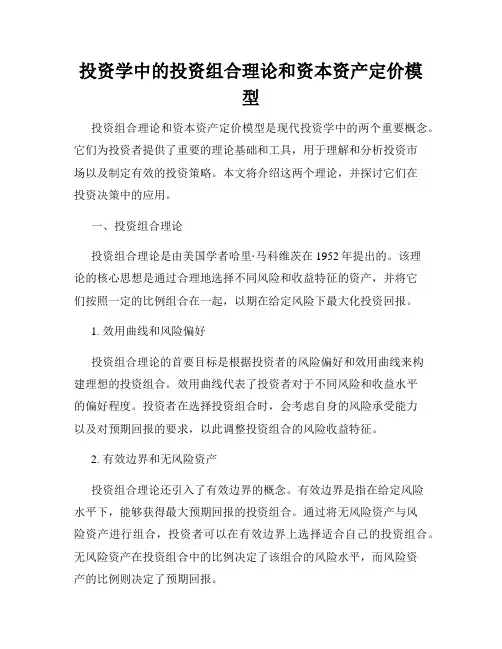
投资学中的投资组合理论和资本资产定价模型投资组合理论和资本资产定价模型是现代投资学中的两个重要概念。
它们为投资者提供了重要的理论基础和工具,用于理解和分析投资市场以及制定有效的投资策略。
本文将介绍这两个理论,并探讨它们在投资决策中的应用。
一、投资组合理论投资组合理论是由美国学者哈里·马科维茨在1952年提出的。
该理论的核心思想是通过合理地选择不同风险和收益特征的资产,并将它们按照一定的比例组合在一起,以期在给定风险下最大化投资回报。
1. 效用曲线和风险偏好投资组合理论的首要目标是根据投资者的风险偏好和效用曲线来构建理想的投资组合。
效用曲线代表了投资者对于不同风险和收益水平的偏好程度。
投资者在选择投资组合时,会考虑自身的风险承受能力以及对预期回报的要求,以此调整投资组合的风险收益特征。
2. 有效边界和无风险资产投资组合理论还引入了有效边界的概念。
有效边界是指在给定风险水平下,能够获得最大预期回报的投资组合。
通过将无风险资产与风险资产进行组合,投资者可以在有效边界上选择适合自己的投资组合。
无风险资产在投资组合中的比例决定了该组合的风险水平,而风险资产的比例则决定了预期回报。
二、资本资产定价模型资本资产定价模型(Capital Asset Pricing Model, CAPM)是由美国学者威廉·夏普、杰克·特雷纳和约翰·林特纳等在1960年代提出的。
该模型通过衡量资产的系统风险和市场风险溢价,为投资者提供了一种计算预期回报的方法。
1. 单一风险因子模型CAPM基于单一风险因子模型,即市场风险因子。
该模型认为资产的预期回报与其对市场整体风险的敏感性成正比。
通过测量资产的贝塔系数,投资者可以估计资产的预期回报。
2. 市场组合和风险溢价CAPM假设市场组合是投资者的选择集合,投资者可以通过投资于市场组合以获取市场平均回报。
该模型进一步假设,资产的预期回报由无风险回报率和风险溢价两部分组成。
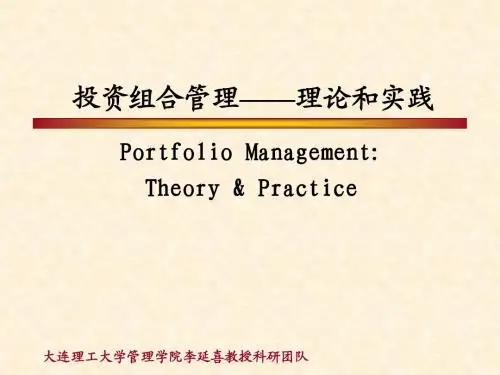
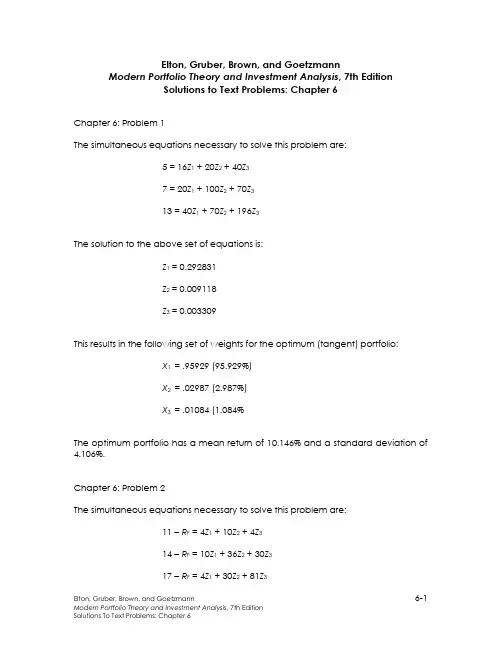
Elton, Gruber, Brown, and GoetzmannModern Portfolio Theory and Investment Analysis, 7th EditionSolutions to Text Problems: Chapter 6Chapter 6: Problem 1The simultaneous equations necessary to solve this problem are:5 = 16Z1 + 20Z2 + 40Z37 = 20Z1 + 100Z2 + 70Z313 = 40Z1 + 70Z2 + 196Z3The solution to the above set of equations is:Z1 = 0.292831Z2 = 0.009118Z3 = 0.003309This results in the following set of weights for the optimum (tangent) portfolio:X1 = .95929 (95.929%)X2 = .02987 (2.987%)X3 = .01084 (1.084%The optimum portfolio has a mean return of 10.146% and a standard deviation of 4.106%.Chapter 6: Problem 2The simultaneous equations necessary to solve this problem are:11 -R F = 4Z1 + 10Z2 + 4Z314 -R F = 10Z1 + 36Z2 + 30Z317 -R F = 4Z1 + 30Z2 + 81Z3The optimum portfolio solutions using Lintner short sales and the given values for R F are: R F = 6% R F = 8% R F = 10%Z 1 3.510067 1.852348 0.194631Z 2-1.043624 -0.526845 -0.010070 Z 3 0.348993 0.214765 0.080537 X 1 0.715950 0.714100 0.682350X 2-0.212870 -0.203100 -0.035290 X 3 0.711800 0.082790 0.282350Tangent (Optimum) Portfolio Mean Return 6.105% 6.419% 11.812%Tangent (Optimum) Portfolio Standard Deviation 0.737% 0.802% 2.971%Chapter 6: Problem 3Since short sales are not allowed, this problem must be solved as a quadratic programming problem. The formulation of the problem is:PFP XR R σθ-=maxsubject to:11=∑=Ni iX0≥i X ∀ iChapter 6: Problem 4This problem is most easily solved using The Investment Portfolio software that comes with the text, but, since all pairs of assets are assumed to have the same correlation coefficient of 0.5, the problem can also be solved manually using the constant correlation form of the Elton, Gruber and Padberg “Simple Techniques” described in a later chapter.To use the software, open up the Markowitz module, select “file” then “new” then “group constant correlation” to open up a constant correlation table. Enter the input data into the appropriate cells by first double clicking on the cell to make it active. Once the input data have been entered, click on “optimizer” and then “run optimizer” (or simply cl ick on the optimizer icon). At that point, you can either select “full Markowitz” or “simple method.”If you select “full Markowitz,” you then select “short sales allowed/riskless lending and borrowing” and then enter 4 for both the lending and borrowin g rate and click “OK.” A graph of the efficient frontier then appears. You may then hit the “Tab” key to jump to the tangent portfolio, then click on “optimizer” and then “show portfolio” (or simply click on the “show portfolio” icon) to view and print the composition (investment weights), mean return and standard deviation of the tangent (optimum) portfolio.If instead you select “simple method,” you then select “short sales allowed with riskless asset” and enter 4 for the riskless rate and click “OK.” A table showing the investment weights of the tangent portfolio then appears.Regardless of the method used, the resulting investment weights for the optimum portfolio are as follows:Asset i X i1 -5.999%2 -17.966%3 21.676%4 0.478%5 -29.585%6 12.693%7 -59.170%8 -14.793%9 3.442%10 189.224%Given the above weights, the optimum (tangent) portfolio has a mean return of 18.907% and a standard deviation of 3.297%. The efficient frontier is a positively sloped straight line starting at the riskless rate of 4% and extending through thetangent portfolio (T) and out to infinity:Chapter 6: Problem 5Since the given portfolios, A and B, are on the efficient frontier, the GMV portfolio can be obtained by finding the minimum-risk combination of the two portfolios:31202163620162222-=⨯-+-=-+-=A B B A A B B GMVA X σσσσσ3111=-=GMVA GMVB X XThis gives %33.7=GMV R and %83.3=GMV σAlso, since the two portfolios are on the efficient frontier, the entire efficient frontier can then be traced by using various combinations of the two portfolios, starting with the GMV portfolio and moving up along the efficient frontier (increasing the weight in portfolio A and decreasing the weight in portfolio B). Since X B = 1 - X A the efficient frontier equations are:()()A A B A A A P X X R X R X R -⨯+=-+=18101()()()()A A A A A BA AB A A A P X X X X X X X X -+-+=-+-+=14011636121222222σσσσSince short sales are allowed, the efficient frontier will extend beyond portfolio A and out toward infinity. The efficient frontier appears as follows:。
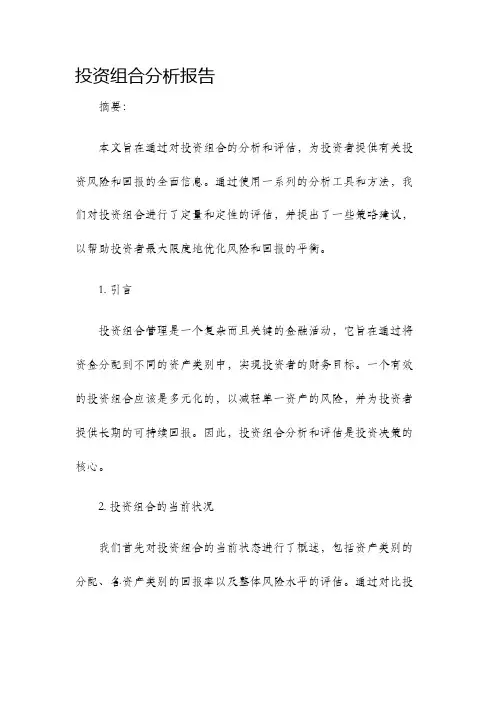
投资组合分析报告摘要:本文旨在通过对投资组合的分析和评估,为投资者提供有关投资风险和回报的全面信息。
通过使用一系列的分析工具和方法,我们对投资组合进行了定量和定性的评估,并提出了一些策略建议,以帮助投资者最大限度地优化风险和回报的平衡。
1. 引言投资组合管理是一个复杂而且关键的金融活动,它旨在通过将资金分配到不同的资产类别中,实现投资者的财务目标。
一个有效的投资组合应该是多元化的,以减轻单一资产的风险,并为投资者提供长期的可持续回报。
因此,投资组合分析和评估是投资决策的核心。
2. 投资组合的当前状况我们首先对投资组合的当前状态进行了概述,包括资产类别的分配、各资产类别的回报率以及整体风险水平的评估。
通过对比投资组合的回报与市场基准的表现,我们可以初步评估投资策略的有效性。
3. 资产分配和风险控制在这一部分,我们详细讨论了资产分配的重要性以及如何最大程度地减少投资组合的风险。
我们介绍了不同的资产类别,并说明了它们的特点和风险-回报关系。
通过定量分析和现代投资理论的应用,我们可以确定最佳的资产配置比例以及相关的风险控制策略。
4. 投资者的目标和风险承受能力在这一部分,我们讨论了投资者的目标和风险承受能力对投资组合决策的重要性。
通过准确评估投资者的目标和风险偏好,我们可以为其提供最合适的投资组合建议,并为其制定适合的投资策略。
5. 投资组合的绩效评估为了评估投资组合的绩效,我们使用了一系列的指标和方法,如夏普比率、特雷诺比率和信息比率等。
这些评价指标可以帮助投资者判断投资组合的回报是否与其承担的风险相匹配,并与市场基准进行对比。
6. 策略建议基于我们的分析和评估结果,我们提供了一些具体的策略建议,以帮助投资者改善投资组合的绩效。
这些建议涉及到资产分配的优化、投资策略的调整以及风险管理的改进等方面。
结论:通过对投资组合的分析和评估,我们可以帮助投资者更好地理解其投资组合的风险和回报,并为其提供相应的建议。
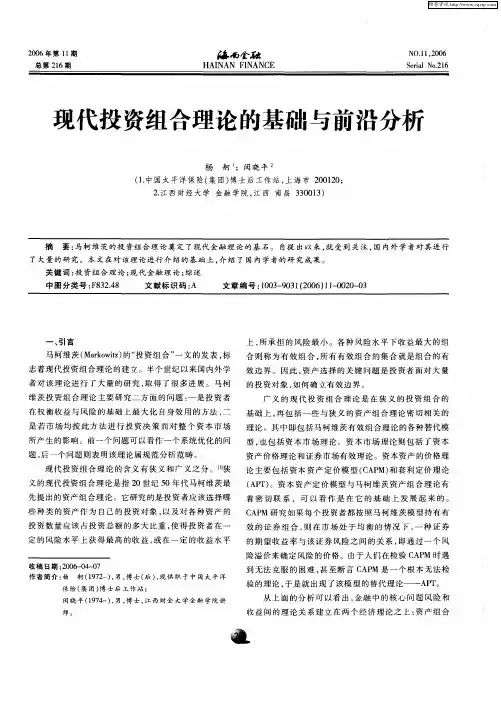
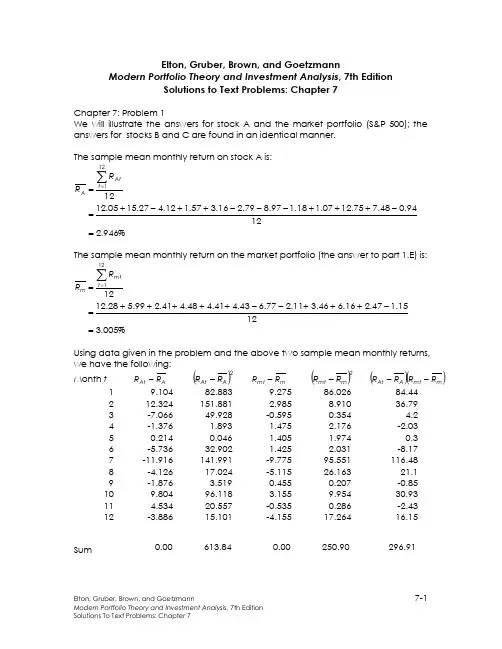
Elton, Gruber, Brown, and GoetzmannModern Portfolio Theory and Investment Analysis , 7th EditionSolutions to Text Problems: Chapter 7Chapter 7: Problem 1We will illustrate the answers for stock A and the market portfolio (S&P 500); the answers for stocks B and C are found in an identical manner.The sample mean monthly return on stock A is:%946.21294.048.775.1207.118.197.879.216.357.112.427.1505.1212121=-+++---++-+==∑=t AtA RRThe sample mean monthly return on the market portfolio (the answer to part 1.E) is:%005.31215.147.216.646.311.277.643.441.448.441.299.528.1212121=-+++--+++++==∑=t m tm RRUsing data given in the problem and the above two sample mean monthly returns, we have the following: Month tAAt R R - ()2AAtR R-mm t R R - ()2mmtR R-()()mm t A AtR R R R--1 9.104 82.883 9.275 86.026 84.442 12.324 151.881 2.985 8.910 36.793 -7.066 49.928 -0.595 0.354 4.2 4 -1.376 1.893 1.475 2.176 -2.03 5 0.214 0.046 1.405 1.974 0.3 6 -5.736 32.902 1.425 2.031 -8.17 7 -11.916 141.991 -9.775 95.551 116.48 8 -4.126 17.024 -5.115 26.163 21.19 -1.876 3.519 0.455 0.207 -0.85 10 9.804 96.118 3.155 9.954 30.93 11 4.534 20.557 -0.535 0.286 -2.43 12-3.886 15.101 -4.155 17.264 16.15Sum0.00613.840.00250.90296.91The sample variance and standard deviation of the stock A’s monthly return are:()15.511284.6131212122==-=∑=t AAtAR Rσ%15.715.51==A σThe sample variance (the answer to part 1.F) and standard deviation of the market portfolio’s monthly return are:()91.201290.2501212122==-=∑=t mm tmR Rσ%57.491.20==m σThe sample covariance of the returns on stock A and the market portfolio is:()()[]74.241291.29612121==--=∑=t mm t A AtAm R R R RσThe sample correlation coefficient of the returns on stock A and the market portfolio (the answer to part 1.D) is:757.057.415.774.24=⨯==mA Am Am σσσρThe sample beta of stock A (the answer to part 1.B) is:183.191.2074.242===mAm A σσβThe sample alpha of stock A (the answer to part 1.A) is:%609.0%005.3183.1%946.2-=⨯-=-=m A A A R R βαEach month’s sample residual is security A’s actual return that month minus the return that month predicted by the regression. The regression’s predic ted monthly return is: mt A A edict ed t A R R βα-=Pr ,,The sample residual for each month t is then: edict ed t A At At R R Pr ,,-=εSo we have the following:Month tAt R edict edt A R Pr,,At ε2At ε112.05 13.92 -1.873.5 2 15.27 6.48 8.79 77.26 3 -4.12 2.24 -6.36 40.45 4 1.57 4.69 -3.12 9.73 5 3.16 4.61 -1.45 2.1 6 -2.79 4.63 -7.42 55.06 7 -8.97 -8.62 -0.35 0.12 8 -1.18 -3.11 1.93 3.72 9 1.07 3.48 -2.41 5.81 10 12.756.68 6.07 36.84 117.48 2.31 5.17 26.73 12 -0.94 -1.97 1.02 1.04Sum: 0.00 262.36Since the sample residuals sum to 0 (because of the way the sample alpha and beta are calculated), the sample mean of the sample residuals also equals 0 and the sample variance and standard deviation of the sample residuals (the answer to part 1.C) are: ()863.211236.26212121211212===-=∑∑==t Att AAtAεεεσε%676.4863.21==A εσRepeating the above analysis for all the stocks in the problem yields: Stock A Stock B Stock Calpha -0.609% 2.964%-3.422%beta 1.183 1.021 2.322correlation with market 0.757 0.684 0.652standard deviation of sample residuals * 4.676% 4.983% 12.341%with %005.3=m R and 91.202=m σ.*Note that most regression programs use N - 2 for the denominator in the sample residual variance formula and use N - 1 for the denominator in the other variance formulas (where N is the number of time series observations). As is explained in the text, we have instead used N for the denominator in all the variance formulas. To convert the variance from a regression program to our results, simply multiply the variance by eitherNN 2- orNN 1-.Chapter 7: Problem 2 A. A.1portfolio from Problem 1 we have:%946.2005.3183.1609.0=⨯+-=A RSimilarly:%032.6=B R ; %556.3=C RThe Sharpe single-index model's formula for a security's variance of return is:2222i m i i εσσβσ+=Using the beta and residual standard deviation for stock A along with the variance of return on the market portfolio from Problem 1 we have:14.51676.491.20183.1222=+⨯=A σSimilarly: 62.462=b σ; 0.2652=c σ A.2From Problem 1 we have:%946.2=A R ; %031.6=B R ; %554.3=C R15.512=A σ; 61.462=B σ; 0.2652=C σ B. B.1According to the Sharpe single-index model, the covariance between the returns on a pair of assets is:2m j i ij SIM σββσ=Using the betas for stocks A and B along with the variance of the market portfolio from Problem 1 we have:254.2591.20021.1183.1=⨯⨯=AB SIM σSimilarly:433.57=AC SIM σ; 568.49=BC SIM σThe formula for sample covariance from the historical time series of 12 pairs of returns on security i and security j is:()()12121∑=--=t j jt i itij R R R RσApplying the above formula to the monthly data given in Problem 1 for securities A, B and C gives:462.18=AB σ; 618.61=AC σ; 085.54=BC σ C. C.1Using the earlier results from the Sharpe single-index model, the mean monthly return and standard deviation of an equally weighted portfolio of stocks A, B and C are:%18.4%556.331%032.631%946.231=⨯+⨯+⨯=P R%348.857.493143.573125.253120.2653162.463115.5131222222=⎪⎪⎭⎫⎝⎛⨯⎪⎭⎫⎝⎛+⨯⎪⎭⎫ ⎝⎛+⨯⎪⎭⎫ ⎝⎛⨯+⨯⎪⎭⎫ ⎝⎛+⨯⎪⎭⎫ ⎝⎛+⨯⎪⎭⎫ ⎝⎛=P σ C.2Using the earlier results from the historical data, the mean monthly return and standard deviation of an equally weighted portfolio of stocks A, B and C are:%18.4%554.331%031.631%946.231=⨯+⨯+⨯=P R%374.808.543162.613146.183120.2653162.463115.5131222222=⎪⎪⎭⎫⎝⎛⨯⎪⎭⎫ ⎝⎛+⨯⎪⎭⎫ ⎝⎛+⨯⎪⎭⎫ ⎝⎛⨯+⨯⎪⎭⎫⎝⎛+⨯⎪⎭⎫ ⎝⎛+⨯⎪⎭⎫ ⎝⎛=P σThe slight differences between the answers to parts A.1 and A.2 are simply due to rounding errors. The results for sample mean return and variance from either the Sharpe single-index model formulas or the sample-statistics formulas are in fact identical.The answers to parts B.1 and B.2 differ for sample covariance because the Sharpe single-index model assumes the covariance between the residual returns of securities i and j is 0 (cov(εi εj ) = 0), and so the single-index form of sample covariance of total returns is calculated by setting the sample covariance of the sample residuals equal to 0. The sample-statistics form of sample covariance of total returns incorporates the actual sample covariance of the sample residuals.The answers in parts C.1 and C.2 for mean returns on an equally weighted portfolio of stocks A, B and C are identical because the Sharpe single-index model formula for the mean return on an individual stock yields a result identical to that of the sample-statistics formula for the mean return on the stock.The answers in parts C.1 and C.2 for standard deviations of return on an equally weighted portfolio of stocks A, B and C are different because the Sharpe single-index model formula for the sample covariance of returns on a pair of stocks yields a result different from that of the sample-statistics formula for the sample covariance of returns on a pair of stocks.Chapter 7: Problem 3Recall from t he text that the Vasicek technique’s forecast of security i ’s beta (2i β) is:121212112121212i i i i i βσσσβσσσβββββββ⨯++⨯+=where 1β is the average beta across all sample securities in the historical period (in this problem referred to as the “market beta”), 1i β is the beta of security i in thehistorical period, 21βσ is the variance of all the sample securities’ betas in the historical period and 21i βσ is the square of the standard error of the estimate of betafor security i in the historical period.If the standard errors of the estimates of all the betas of the sample securities in the historical period are the same, then, for each security i , we have:a i =21βσ where a is a constant across all the sample securities.Therefore, we have for any security i :()111212112121i i i X X aa aβββσσβσββββ-+=⨯++⨯+=This shows that, under the assumption that the standard errors of all historical betas are the same, the forecasted beta for any security using the Vasicek technique is a simple weighted average (proportional weighting) of 1β (the “market beta”) and 1i β (the security’s historical beta), where the weights are the same for each security.Chapter 7: Problem 4Letting the historical period of the year of monthly returns given in Problem 1 equal 1 (t = 1), then the forecast period equals 2 and the Blume forecast equation is:1260.041.0i i ββ+=Using the earlier answer to Problem 1 for the estimate of beta from the historical period for stock A along with the above equation we obtain the stock’s forecasted beta:120.1183.160.041.060.041.012=⨯+=+=A A ββSimilarly:023.12=B β; 803.12=C βChapter 7: Problem 5 A.%4.13=B R ; %4.7=C R ; %2.11=D R B.σ2B = 43.25; σ2C = 20; σ2D = 36.25 C.σAC = 30; σAD = 33.75; σBC = 26; σBD = 29.25; σCD = 18Chapter 7: Problem 6 A.Recall that the formula for a portfolio's beta is: i N is the number of assets in the portfolio.Since there are four assets in Problem 5, N = 4 and X i equals 1/4 for each asset in。
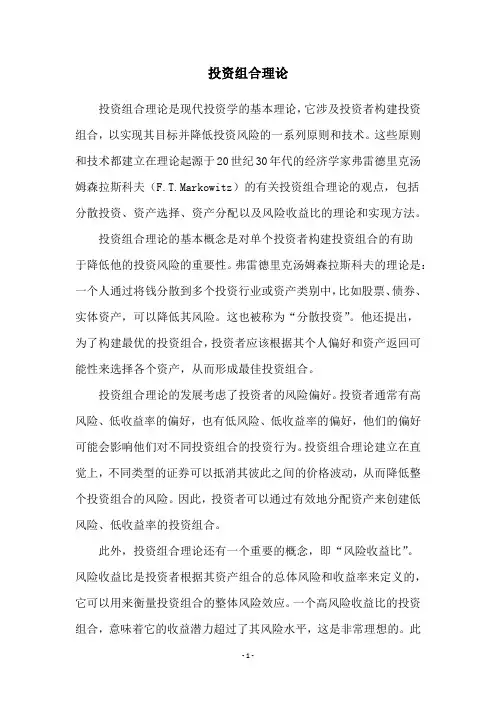
投资组合理论投资组合理论是现代投资学的基本理论,它涉及投资者构建投资组合,以实现其目标并降低投资风险的一系列原则和技术。
这些原则和技术都建立在理论起源于20世纪30年代的经济学家弗雷德里克汤姆森拉斯科夫(F.T.Markowitz)的有关投资组合理论的观点,包括分散投资、资产选择、资产分配以及风险收益比的理论和实现方法。
投资组合理论的基本概念是对单个投资者构建投资组合的有助于降低他的投资风险的重要性。
弗雷德里克汤姆森拉斯科夫的理论是:一个人通过将钱分散到多个投资行业或资产类别中,比如股票、债券、实体资产,可以降低其风险。
这也被称为“分散投资”。
他还提出,为了构建最优的投资组合,投资者应该根据其个人偏好和资产返回可能性来选择各个资产,从而形成最佳投资组合。
投资组合理论的发展考虑了投资者的风险偏好。
投资者通常有高风险、低收益率的偏好,也有低风险、低收益率的偏好,他们的偏好可能会影响他们对不同投资组合的投资行为。
投资组合理论建立在直觉上,不同类型的证券可以抵消其彼此之间的价格波动,从而降低整个投资组合的风险。
因此,投资者可以通过有效地分配资产来创建低风险、低收益率的投资组合。
此外,投资组合理论还有一个重要的概念,即“风险收益比”。
风险收益比是投资者根据其资产组合的总体风险和收益率来定义的,它可以用来衡量投资组合的整体风险效应。
一个高风险收益比的投资组合,意味着它的收益潜力超过了其风险水平,这是非常理想的。
此外,当一个投资者计算其风险收益比时,他需要考虑整个投资者群体的表现,而不仅仅只看个人的投资情况,以便确保他的投资组合是有效的。
在20世纪50年代和60年代,投资组合理论发展得更加细致,出现了如资产定价模型和投资机会成本等概念。
投资组合理论也成为金融管理学的基本原理之一,不仅在美国,而且在各个国家和地区也都很受欢迎。
随着投资组合理论的普及,美国证券交易委员会(SEC)在1975年通过了《证券投资顾问法》,将投资组合理论作为投资顾问的主要准则。
Elton, Gruber, Brown, and GoetzmannModern Portfolio Theory and Investment Analysis , 7th EditionSolutions to Text Problems: Chapter 7Chapter 7: Problem 1We will illustrate the answers for stock A and the market portfolio (S&P 500); the answers for stocks B and C are found in an identical manner.The sample mean monthly return on stock A is:%946.21294.048.775.1207.118.197.879.216.357.112.427.1505.1212121=-+++---++-+==∑=t AtA RRThe sample mean monthly return on the market portfolio (the answer to part 1.E) is:%005.31215.147.216.646.311.277.643.441.448.441.299.528.1212121=-+++--+++++==∑=t m tm RRUsing data given in the problem and the above two sample mean monthly returns, we have the following: Month tAAt R R - ()2AAtR R-mm t R R - ()2mmtR R-()()mm t A AtR R R R--1 9.104 82.883 9.275 86.026 84.442 12.324 151.881 2.985 8.910 36.793 -7.066 49.928 -0.595 0.354 4.2 4 -1.376 1.893 1.475 2.176 -2.03 5 0.214 0.046 1.405 1.974 0.3 6 -5.736 32.902 1.425 2.031 -8.17 7 -11.916 141.991 -9.775 95.551 116.48 8 -4.126 17.024 -5.115 26.163 21.19 -1.876 3.519 0.455 0.207 -0.85 10 9.804 96.118 3.155 9.954 30.93 11 4.534 20.557 -0.535 0.286 -2.43 12-3.886 15.101 -4.155 17.264 16.15Sum0.00613.840.00250.90296.91The sample variance and standard deviation of the stock A’s monthly return are:()15.511284.6131212122==-=∑=t AAtAR Rσ%15.715.51==A σThe sample variance (the answer to part 1.F) and standard deviation of the market portfolio’s monthly return are:()91.201290.2501212122==-=∑=t mm tmR Rσ%57.491.20==m σThe sample covariance of the returns on stock A and the market portfolio is:()()[]74.241291.29612121==--=∑=t mm t A AtAm R R R RσThe sample correlation coefficient of the returns on stock A and the market portfolio (the answer to part 1.D) is:757.057.415.774.24=⨯==mA Am Am σσσρThe sample beta of stock A (the answer to part 1.B) is:183.191.2074.242===mAm A σσβThe sample alpha of stock A (the answer to part 1.A) is:%609.0%005.3183.1%946.2-=⨯-=-=m A A A R R βαEach month’s sample residual is security A’s actual return that month minus the return that month predicted by the regression. The regression’s predic ted monthly return is: mt A A edict ed t A R R βα-=Pr ,,The sample residual for each month t is then: edict ed t A At At R R Pr ,,-=εSo we have the following:Month tAt R edict edt A R Pr,,At ε2At ε112.05 13.92 -1.873.5 2 15.27 6.48 8.79 77.26 3 -4.12 2.24 -6.36 40.45 4 1.57 4.69 -3.12 9.73 5 3.16 4.61 -1.45 2.1 6 -2.79 4.63 -7.42 55.06 7 -8.97 -8.62 -0.35 0.12 8 -1.18 -3.11 1.93 3.72 9 1.07 3.48 -2.41 5.81 10 12.756.68 6.07 36.84 117.48 2.31 5.17 26.73 12 -0.94 -1.97 1.02 1.04Sum: 0.00 262.36Since the sample residuals sum to 0 (because of the way the sample alpha and beta are calculated), the sample mean of the sample residuals also equals 0 and the sample variance and standard deviation of the sample residuals (the answer to part 1.C) are: ()863.211236.26212121211212===-=∑∑==t Att AAtAεεεσε%676.4863.21==A εσRepeating the above analysis for all the stocks in the problem yields: Stock A Stock B Stock Calpha -0.609% 2.964%-3.422%beta 1.183 1.021 2.322correlation with market 0.757 0.684 0.652standard deviation of sample residuals * 4.676% 4.983% 12.341%with %005.3=m R and 91.202=m σ.*Note that most regression programs use N - 2 for the denominator in the sample residual variance formula and use N - 1 for the denominator in the other variance formulas (where N is the number of time series observations). As is explained in the text, we have instead used N for the denominator in all the variance formulas. To convert the variance from a regression program to our results, simply multiply the variance by eitherNN 2- orNN 1-.Chapter 7: Problem 2 A. A.1portfolio from Problem 1 we have:%946.2005.3183.1609.0=⨯+-=A RSimilarly:%032.6=B R ; %556.3=C RThe Sharpe single-index model's formula for a security's variance of return is:2222i m i i εσσβσ+=Using the beta and residual standard deviation for stock A along with the variance of return on the market portfolio from Problem 1 we have:14.51676.491.20183.1222=+⨯=A σSimilarly: 62.462=b σ; 0.2652=c σ A.2From Problem 1 we have:%946.2=A R ; %031.6=B R ; %554.3=C R15.512=A σ; 61.462=B σ; 0.2652=C σ B. B.1According to the Sharpe single-index model, the covariance between the returns on a pair of assets is:2m j i ij SIM σββσ=Using the betas for stocks A and B along with the variance of the market portfolio from Problem 1 we have:254.2591.20021.1183.1=⨯⨯=AB SIM σSimilarly:433.57=AC SIM σ; 568.49=BC SIM σThe formula for sample covariance from the historical time series of 12 pairs of returns on security i and security j is:()()12121∑=--=t j jt i itij R R R RσApplying the above formula to the monthly data given in Problem 1 for securities A, B and C gives:462.18=AB σ; 618.61=AC σ; 085.54=BC σ C. C.1Using the earlier results from the Sharpe single-index model, the mean monthly return and standard deviation of an equally weighted portfolio of stocks A, B and C are:%18.4%556.331%032.631%946.231=⨯+⨯+⨯=P R%348.857.493143.573125.253120.2653162.463115.5131222222=⎪⎪⎭⎫⎝⎛⨯⎪⎭⎫⎝⎛+⨯⎪⎭⎫ ⎝⎛+⨯⎪⎭⎫ ⎝⎛⨯+⨯⎪⎭⎫ ⎝⎛+⨯⎪⎭⎫ ⎝⎛+⨯⎪⎭⎫ ⎝⎛=P σ C.2Using the earlier results from the historical data, the mean monthly return and standard deviation of an equally weighted portfolio of stocks A, B and C are:%18.4%554.331%031.631%946.231=⨯+⨯+⨯=P R%374.808.543162.613146.183120.2653162.463115.5131222222=⎪⎪⎭⎫⎝⎛⨯⎪⎭⎫ ⎝⎛+⨯⎪⎭⎫ ⎝⎛+⨯⎪⎭⎫ ⎝⎛⨯+⨯⎪⎭⎫⎝⎛+⨯⎪⎭⎫ ⎝⎛+⨯⎪⎭⎫ ⎝⎛=P σThe slight differences between the answers to parts A.1 and A.2 are simply due to rounding errors. The results for sample mean return and variance from either the Sharpe single-index model formulas or the sample-statistics formulas are in fact identical.The answers to parts B.1 and B.2 differ for sample covariance because the Sharpe single-index model assumes the covariance between the residual returns of securities i and j is 0 (cov(εi εj ) = 0), and so the single-index form of sample covariance of total returns is calculated by setting the sample covariance of the sample residuals equal to 0. The sample-statistics form of sample covariance of total returns incorporates the actual sample covariance of the sample residuals.The answers in parts C.1 and C.2 for mean returns on an equally weighted portfolio of stocks A, B and C are identical because the Sharpe single-index model formula for the mean return on an individual stock yields a result identical to that of the sample-statistics formula for the mean return on the stock.The answers in parts C.1 and C.2 for standard deviations of return on an equally weighted portfolio of stocks A, B and C are different because the Sharpe single-index model formula for the sample covariance of returns on a pair of stocks yields a result different from that of the sample-statistics formula for the sample covariance of returns on a pair of stocks.Chapter 7: Problem 3Recall from t he text that the Vasicek technique’s forecast of security i ’s beta (2i β) is:121212112121212i i i i i βσσσβσσσβββββββ⨯++⨯+=where 1β is the average beta across all sample securities in the historical period (in this problem referred to as the “market beta”), 1i β is the beta of security i in thehistorical period, 21βσ is the variance of all the sample securities’ betas in the historical period and 21i βσ is the square of the standard error of the estimate of betafor security i in the historical period.If the standard errors of the estimates of all the betas of the sample securities in the historical period are the same, then, for each security i , we have:a i =21βσ where a is a constant across all the sample securities.Therefore, we have for any security i :()111212112121i i i X X aa aβββσσβσββββ-+=⨯++⨯+=This shows that, under the assumption that the standard errors of all historical betas are the same, the forecasted beta for any security using the Vasicek technique is a simple weighted average (proportional weighting) of 1β (the “market beta”) and 1i β (the security’s historical beta), where the weights are the same for each security.Chapter 7: Problem 4Letting the historical period of the year of monthly returns given in Problem 1 equal 1 (t = 1), then the forecast period equals 2 and the Blume forecast equation is:1260.041.0i i ββ+=Using the earlier answer to Problem 1 for the estimate of beta from the historical period for stock A along with the above equation we obtain the stock’s forecasted beta:120.1183.160.041.060.041.012=⨯+=+=A A ββSimilarly:023.12=B β; 803.12=C βChapter 7: Problem 5 A.%4.13=B R ; %4.7=C R ; %2.11=D R B.σ2B = 43.25; σ2C = 20; σ2D = 36.25 C.σAC = 30; σAD = 33.75; σBC = 26; σBD = 29.25; σCD = 18Chapter 7: Problem 6 A.Recall that the formula for a portfolio's beta is: i N is the number of assets in the portfolio.Since there are four assets in Problem 5, N = 4 and X i equals 1/4 for each asset in。
股票投资中投资组合理论的应用分析投资组合理论是股票投资中的一个重要理论,它是通过将不同种类的股票组合在一起来降低投资风险和增加收益。
在实际操作中,我们需要通过对不同种类股票的分析和研究,根据个人的风险偏好和目标收益来选择合适的投资组合。
投资组合理论的基本思想是利用不同种类股票之间的相关性来实现投资组合的分散化,从而降低整个投资组合的风险。
投资者可以通过建立一个便于资产配置、风险管理和收益优化的投资组合,实现投资目标和资产配置的最优化。
在实践中,投资者需要了解不同股票之间的风险和收益关系,以及市场和行业对个别股票的影响。
基于此,投资者可以分析股票的基本面、经济环境和政策变化等因素,进一步选择适合自己的投资组合。
投资组合理论不仅能够帮助投资者降低投资风险,还可以为投资者提供更多的机会来获取收益。
例如,当某些股票的价格下跌时,投资者可以选购这些公司的股票,以此博取短期的收益。
同时,投资者还可以通过股票的交易量、市场涨跌幅和盈利情况等因素来确定买卖操作的时机和方向,以更好地实现其投资目标。
在投资组合理论的应用中,还需要特别注意的是,投资组合的风险并不完全等于其风险的加权平均值。
因为不同股票之间的相关性会影响整个投资组合的风险水平。
因此,通过将不同股票之间的相关性考虑在内,可以更准确地评估投资组合的风险水平,从而实现最优化的资产配置。
总之,投资组合理论是股票投资中非常重要的理论之一,它为投资者提供了一种有效的方式来降低投资风险,并获得更高的收益。
通过研究不同股票之间的相关性和投资者的投资需求,我们可以选择合适的投资组合来实现最优化的资产配置和风险管理。
同时,投资者还可以通过不断学习和实践,逐步提高其投资技巧和思考水平,实现持续的增长和收益。
投资组合理论投资组合理论是金融研究中一个重要的理论,它试图解决如何在投资决策过程中实现最佳的投资组合。
投资组合理论的核心是资产多样化、风险分散、风险分散和投资者最佳投资组合的概念。
它分析了来自各种资产类别的投资者风险和收益特征,探讨了如何根据投资者自身的风险特征和投资目标,选择最佳的投资组合。
投资组合理论的起源可以追溯到1952年,当时美国经济学家威廉莫瑞尔(William Sharpe)提出了投资组合理论,并发表了著名的《投资组合有效性理论》(The Theory of Portfolio Efficiency)。
在那时,莫瑞尔将投资投资风险、投资收益和资产收益率之间的关系建模,论述了投资组合有效性理论,提出了投资者可以通过组合多种资产来实现最佳投资组合的思想。
随着近20年市场全球化进程的加快,各种资产组合的多样性和多元性也在不断增强,投资组合理论在经济学研究中也越来越重要。
投资组合理论理论讨论了投资者如何规划投资、如何实施投资、如何评估投资的实际结果等问题。
投资组合理论是关于风险、收益、投资结构和投资者等金融研究的理论,它以金融机构资产管理业务为核心,涵盖了金融市场经济学、财务管理学、资产定价学、资产估值学等学科。
该理论考虑了投资者在投资过程中收益和风险之间的矛盾,从而探讨了如何平衡风险和收益,获得最佳投资组合的概念。
投资组合理论可以用于分析资金的配置和资产的结构,以确定最佳的投资组合,从而实现投资者的投资目标。
它分析了资产组合在不同市场条件下投资者收益和风险之间的变化,探讨了如何根据投资者自身的风险特征和投资目标,选择最佳的投资组合。
投资组合理论的一个关键概念是风险分散,它的原则是投资者应该尽可能将投资风险分散到不同的资产与投资中,以消除或减少投资组合中的对冲风险。
另一个概念是资产配置,也就是说,投资者应根据自己的投资目标、风险特征和投资规划,综合考虑风险和收益因素,以来决定最佳的投资组合结构。
投资组合理论及其在实践中的应用投资组合理论是现代金融学的重要理论之一,它以马科维茨的资产组合理论为基础,旨在通过构建适当的投资组合来实现风险和收益的最优平衡。
投资组合理论的核心思想是通过将不相关的或低相关性的资产组合在一起,可以降低总体风险,提高收益。
一、投资组合理论的基本原理投资组合理论的基本原理可归纳为以下几点:1. 风险多样化:通过组合不同类型或不同类别的资产,可以实现对冲风险的目的。
当一个投资品的价值下跌时,另一个投资品的价值可能上涨,从而减少总体风险。
2. 预期收益与风险的权衡:投资者通常会对预期收益与风险之间的关系进行权衡。
对于风险厌恶的投资者而言,他们更倾向于选择风险较低的投资组合,即使预期收益较低。
3. 有效前沿:有效前沿是指在给定风险水平下,可以实现最大预期收益的所有投资组合。
有效前沿的存在使得投资者可以选择最佳的投资组合,以满足其风险偏好和收益目标。
4. 无风险资产的引入:在实践中,投资组合中通常会引入无风险资产(如国债),以实现更好的风险收益平衡。
通过在无风险资产和高风险资产之间调整权重,投资者可以根据自身的风险偏好选择最佳的投资组合。
二、投资组合理论在实践中的应用1. 个人投资者:对于个人投资者而言,投资组合理论提供了一种科学的方法来优化个人的投资组合。
根据个人的风险承受能力和收益目标,个人投资者可以通过选取适当的资产组合来达到风险最小化或收益最大化的目标。
2. 机构投资者:机构投资者通常管理着大额资金,其投资决策对市场具有较大的影响力。
基于投资组合理论,机构投资者可以通过分散投资于不同类型的资产,降低整体风险,并获得更好的长期收益。
3. 资产管理公司:资产管理公司可以利用投资组合理论来为客户提供专业的投资组合管理服务。
通过根据客户的风险偏好和收益目标构建适当的投资组合,资产管理公司可以帮助客户实现资产增值和风险控制。
4. 金融学研究:投资组合理论在金融学研究中发挥着重要作用。
投资组合理论及其在实践中的应用分析投资组合理论是现代金融学的基石之一,它核心思想是通过投资于多种资产,降低投资风险,提高投资回报。
本文将对投资组合理论及其在实践中的应用进行深入分析。
第一部分:投资组合理论的基础1.1 投资组合的定义投资组合是指投资者对于不同的资产,根据其风险收益性质的不同特点,在不同条件下,选择若干种资产进行投资的一种手段。
投资组合可以将个别资产的风险和回报平均化,从而得到一个更为稳健的投资方案。
1.2 马科维茨理论马科维茨理论是投资组合理论的重要组成部分之一。
该理论的核心假设是,投资风险并不是单一资产的风险,而是整体投资组合的风险。
因此,通过选择不同风险和回报特征的资产进行投资,可以构建出低风险、高回报的投资组合。
1.3 投资组合的效用投资组合的效用是指投资者通过选择不同资产配比所获得的收益,即投资者的满意程度。
在马科维茨理论中,有效前沿是基于投资者的效用函数和各资产期望收益率以及协方差矩阵构成的。
第二部分:投资组合在实践中的应用2.1 当前市场背景下的投资组合策略在当前市场背景下,投资者面临着多重挑战,如低利率环境、经济复苏步履维艰等。
因此,投资者可以采取一些投资组合策略,来降低投资风险,提高投资回报。
首先,可以采用资产配置策略,即根据自身风险承受能力,选择适合自己的投资组合。
其次,可以采用动态资产配置策略,即根据市场环境变化,及时调整投资组合。
最后,则可以采用多元化投资策略,即将资金分散到多个不同行业、不同地区的资产中,降低整体投资组合风险。
2.2 回顾近期投资组合表现回顾近期投资组合表现,可以看到,在全球市场波动剧烈的情况下,一些投资组合取得了不错的表现。
比如,在新冠疫情带来的负面影响下,科技股和互联网股表现强劲;在通货膨胀和资产价格上涨的背景下,一些对冲基金的投资组合表现也相对良好。
然而,需要注意的是,过度依赖历史数据和定期再平衡,可能会导致所选投资组合与市场脱节,最终影响投资回报。
投资组合理论模型及证券选择的实证分析金融091 5400109034 覃珍和摘要:投资组合理论有狭义和广义之分。
狭义的投资组合理论指的是马柯维茨投资组合理论;而广义的投资组合理论除了经典的投资组合理论以及该理论的各种替代投资组合理论外,还包括由资本资产定价模型和证券市场有效理论构成的资本市场理论。
本文主要讲述的是马柯维茨的均值---方差理论和投资组合有效边界理论,通过理论的分析,结合投资者的风险偏好程度,构造合适的证券投资组合,合理分配其权重,使证券组合达到预期的收益率和风险度。
关键词:均值---方差模型,权重,风险偏好,收益率,有效边界(一)投资组合理论的提出美国经济学家马柯维茨(Markowitz)1952年首次提出投资组合理论(Portfolio Theory),并进行了系统、深入和卓有成效的研究,他因此获得了诺贝尔经济学奖。
该理论包含两个重要内容:均值-方差分析方法和投资组合有效边界模型。
在发达的证券市场中,马科维茨投资组合理论早已在实践中被证明是行之有效的,并且被广泛应用于组合选择和资产配置。
但是,我国的证券理论界和实务界对于该理论是否适合于我国股票市场一直存有较大争议。
从狭义的角度来说,投资组合是规定了投资比例的一揽子有价证券,当然,单只证券也可以当作特殊的投资组合。
人们进行投资,本质上是在不确定性的收益和风险中进行选择。
投资组合理论用均值—方差来刻画这两个关键因素。
所谓均值,是指投资组合的期望收益率,它是单只证券的期望收益率的加权平均,权重为相应的投资比例。
当然,股票的收益包括分红派息和资本增值两部分。
所谓方差,是指投资组合的收益率的方差。
我们把收益率的标准差称为波动率,它刻画了投资组合的风险。
人们在证券投资决策中应该怎样选择收益和风险的组合呢?这正是投资组合理论研究的中心问题。
投资组合理论研究“理性投资者”如何选择优化投资组合。
所谓理性投资者,是指这样的投资者:他们在给定期望风险水平下对期望收益进行最大化,或者在给定期望收益水平下对期望风险进行最小化。
现代投资组合理论与投资分析
---------------I09660112 09数学与应用数学一班 冯晨
本学期,我们跟着骆桦老师学习投资组合,收获良多。
让我们知道什么是投资组合,如何利用投资组合来使我们的投资风险降到最低。
还有很多知识,如有效投资、投资组合分析、资本资产定价模型、套利定价模型、公司两阶段增长模型、期权定价理论等等,很多很多。
下面是本学期期末任务,分四个部分:
1、对资本资产定价模型的认识
课本上使用简单方法和严格方法推导,我们可以得到资本资产定价模型相同的结果如下:
()
i M F i F R R R R β=+-
其中i R 是资产i 的预期回报率,
F
R 是无风险回报率,i β
是贝塔系数,即资
产i 的系统性风险, M R 是市场m 的预期市场回报率,M F R R - 是市场风险溢价(market risk premium ),即预期市场回报率与无风险回报率之差。
这个关系式是金融领域最重要的发现之一。
这个方程也称为证券市场线,描述了经济中所有资产与投资组合的期望收益率的关系。
任何资产或投资组合的收益率,无论是否是有效率的收益率,都可以由这一关系确定。
这里,M R 和
F
R 并
不是我们所要考察的资产的函数,所以任意两个资产的期望收益率的关系可以简单的归因于它们具有不同的贝塔值,并且贝塔值越高则均衡收益率也越高。
这里的贝塔值是系统风险的度量指标,这是由于非系统风险总可以通过分散投资还消除的。
资本资产定价模型的应用。
资本资产定价模型主要应用于资产估值和资源配置等方面。
1资产估值是指应用资本资产定价模型可以估计一个证券的均衡状态的价格,将这个价格与现行的实际市场价格相比就可以知道这个证券是否偏离均衡价格,如果偏离,那么后续必定会回归到均衡价,利用这一点,我们便可获得超额收益。
2资源配置的应用就是根据对市场走势的预测来选择具有不同贝塔系数的证券或组合以获得较高收益或规避市场风险。
证券市场线表明,贝塔系数反映证券或组合对市场变化的敏感性,因此,当有很大把握预测牛市到来时,应选择那些高贝塔系数的证券或组合。
这些高贝塔系数的证券将成倍地放大市场收益率,带来较高的收益。
相反,在熊市到来之际,应选择那些低贝塔系数的证券或组合,以减少因市场下跌而造成的损失。
2、对套利定价模型的认识
在事先给定收益产生的条件下推导均衡,这样我们就可以得到套利定价模型。
这一定价模型要求任何股票的收益都与下式中的一组指数线性相关:
1122i i i i ij j i
R a b I b I b I e =+++++
i
a 表示所有指数都为0时股票i 的期望收益水平;
j
I 表示影响股票i 收益的第j
个指数的值;ij
b 表示股票i 收益对第j 个指数的敏感度;i
e 表示均值为0方差为
2
ei
σ的随机误差项。
套利定价模型的应用主要是对消极管理以及积极管理的重要作用。
1消极管理。
多指数模型对优化消极管理有重要作用,可用于追踪一个指数或者设置一个适合特定客户的消极组合。
主要操作方法是按照其指数比例来持有相同比例的股票,这样构建一个指数基金。
2积极管理。
套利定价模型的一个应用就是确定被高估或者低估价值的股票。
在这一程序中,分析师给出股票收益的预测值。
然后套利定价模型与股票对因素的敏感度的估计值一起使用,以计算(使用如112233i F i i i R R b b b λλλ-=+++ 这样的方程)出所要求的股票收益。
给定股票敏感度和λ的情况下,如果估计收益高于计算出的要求回报率,股票应被买入。
3、两阶段增长模型
我们用课本上的原题来更好地理解该模型。
原题如下:在某个时期,xyz 公司股票的每股出售价格是65美元,每股盈利是3.99美元,支付的股利为2.00美元。
与此同时,一家大型经纪公司对xyz 公司的长期增长率的估计值为12%,公司股利支付率为50%。
如果我们假定13%是xyz 公司的一个合适的贴现率。
请计算一下该公司股票的一个理论价格。
两阶段增长模型的意思是说假定一个异常增长阶段将持续N 年,这个阶段的增长率假定为
1
g ,这之后增长将变为一个稳定的水平并持续到无限期,记
N
P 为
第N 年末的价格。
记g
M
为市盈率,经过一系列推导即可得到两阶段增长模型的
表达式如下:
()()()()()1
1
1
011111
111N N
N g N
N
k g D P M E g k g k k -⎡⎤⎡⎤
+-+=++⎢⎥⎢⎥-++⎢⎥⎢⎥⎣
⎦
⎣
⎦
回归到例题上,我们假定分析师预期xyz 公司12%的增长率可以持续15年,之后分析师预期该公司将成为一个平均公司。
此外,假定16年后,预期的时长
市盈率是9.5(市盈率计算公式:
P
S E =
,其中P 为当前股价,E 为每股年净收
益)。
那么xyz 公司股票的理论价值应当是:
()()()()()1515
14
015
15
1.13 1.12
2.00
1
9.5 3.99 1.1254.590.130.12 1.13 1.13P ⎡⎤⎡⎤
-=+⨯⨯=⎢⎥⎢⎥-⎢⎥⎢⎥⎣
⎦
⎣
⎦
相比单阶段模型计算理论股价,两阶段所计算出的股价更有实际意义,但是即使是这样,这个只是一种计算模型,并且必须对这个两个阶段做出的假设,所以这个计算结果依然是粗略的。
4、对期权定价模型的认识及原题解析
期权是一种合约,它赋予持有者在未来某个时间或一段时间内以特定价格买进或卖出指定证券的权利。
假定一个股票的连续复合收益率服从正态分布,就可以得到布莱克—斯科尔斯期权定价公式如下:
0122
01202()()ln(/)(/2)ln(/)(/2)rt
E C S N d N d e S E r t d t S E r t
d t σσσσ⎧=-⎪⎪
⎪++=
⎨⎪
⎪+-=
⎪⎩
其中r 表示连续复合无风险利率;C 表示期权当前价值;0
S 表示股票当前价格;
E 表示期权的执行价格;e 表示常数2.7183;t 表示距离到期日的时间,以年为单位;σ表示连续复合年收益率的标准差;()N d 表示自变量取d 时的标准正态分布的分布函数值。
期权定价公式的应用。
在知道股票的现行价格、期权的执行价格、距离到期日的时间、正态分布函数表、无风险利率水平以及股票连续复合年收益率的标准差。
标准差是最难得到的,我们可以假定股票收益率在整个期限里是同分布的,那么可以使用股票收益率的历史数据来计算这个标准差。
然后运用期权定价公式就可以得到看涨期权的理论价值,如果这个期权的的市场价格低于理论值,那么说明这个期权的价值在市场上就被低估了,这时投资者可以直接买入看涨期权来获利。
课本P410原题如下: 利用布莱克—斯科尔斯公式模型计算以下看涨期权的价值。
股票当前价格为95美元,股票s 收益率的及时标准差为0.6,看涨期权的执行价格为105美元,8个月后到期,连续复合风险利率为8%。
解:已知0S =95,E =105,r =0.08,t =8/12=2/3,σ=0.6,
()()14952068
.03
2/*
6.03
2
*6
.0*2108.0105/95ln 21/ln 2
2
01≈⎪⎭⎫ ⎝
⎛++=
⎪⎭
⎫
⎝
⎛
++=
t
t r E S d σσ
()()340377267
.-03
2/*
6.03
2*
6.0*21-08.0105/95ln 21-/ln 22
02≈⎪⎭⎫
⎝⎛+=
⎪⎭
⎫
⎝⎛
+=
t
t r E S d σσ
则查标准正态分布表得()5596.01=d N ,()3669.02=d N ,
所以得
结束语:
国内外投资界对定量技术的接受速度远远超出了我们最初的想象。
应用现代
投资组合技术分析股票与债券、股利贴现模型、消极投资组合管理的概念、投资组合中融入国际资产、应用期货和期权管理风险,这些已经非常普遍。
投资世界依然在继续变化。
我们刚开始相信资本资产定价模型(CAPM )对现实有描述力,套利定价模型(APT )就出现了;我们刚开始使自己相信市场是有效的,市场非理性就成为热点话题;我们刚开始说证券分析不会得到回报,我们就证明了在价格揭示不完全的世界里分析成本的合理性;市场时机刚开始被怀疑,现在它又以策略资产配置的名义重现。
()()(美元)
64.16.36690*7183
.2105-
5596.0*95-3
2/*08.0210≈==d N e
E d N S C rt。